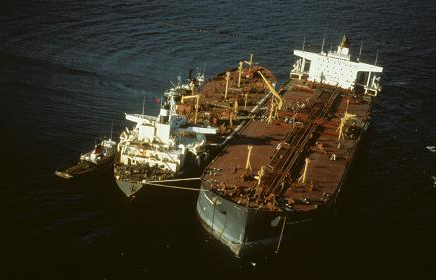
This Sunday, Alaska marks the 30th anniversary of an event that changed the state forever. On March 24th, 1989, 11 million gallons of crude oil spilled into Prince William Sound when the Exxon Valdez tanker ran aground.
Three decades later, the Prince William Sound Regional Citizen’s Advisory Council has an important role in making sure a disaster of that magnitude doesn’t happen again. Joe Lally is director of programs for the organization. Lally is a former member of the Coast Guard and served as captain of the port for Prince William Sound.
Living in Valdez, Lally says he enjoys fishing in the pristine waters of the sound. He told Alaska Public Media’ Wesley Early that his mission on the council is to make sure it stays that way.
LALLY: The role of the RCAC is to ensure the complacency that led to the original oil spill back in 1989, that that complacency doesn’t creep back in. We wanna make sure that we have the most effective and reliable prevention and response system in place.
EARLY: So last year, Alyeska Pipeline Service Compnay switched contractors for oil spill prevention and response in the area from Crowley to Edison Chouest. The RCAC expressed concerned about the new crews and how they were being trained. Do you still have those concerns?
LALLY: No. We worked very closely during the the Edison Chouest transition. We are always going to be concerned, but the initial concerns were that the transition was occurring over too short a period of time, that it was rushed in a way. The total transition included five new escort tugs, four new general purpose tugs, a new anchor-handling, or utility tug, and then four new purpose-built oil spill response barges. And then on top of that, 150 or more new crew members. So, our concerns were that this was all happening in too short a period of time, but we ended up going out on over 40 exercises. So our personnel went out on those exercises and observed what was going on, the operational aspects, and then we would offer our recommendations if we noticed anything, or our observations that would just work to improve the system and help them to make any operational changes that they might need to make.
EARLY: Does the RCAC have any concerns with the state budget and how it’s potentially impacting oil spill and response in Prince William Sound?
LALLY: Yes. The Prince William Sound RCAC just recently visited Juneau, shortly after the budget was released. And we just wanna make sure that the state is fully prepared in case there is another big oil spill. They estimate that if a spill were to occur the size of Exxon Valdez, it would cost the state upwards of $500 million in today’s dollars. And then the cost to all parties could exceed $6 billion. So we wanna make sure that the budget for the state is protected and make sure the prevention response system that is currently in place is not in any way rolled back, weakened or eroded.
EARLY: You mentioned all the work that had been put in, and the spill was devastating in for wildlife in the Sound initially. But how about long term? What populations still haven;t recovered from the Exxon Valdez spill?
LALLY: There are specific species. I know that herring was impacted and has not bounced back. We’ve actually witnessed and have seen where you can go out on these island and dig and go down six inches to a foot, and come up with fresh oil just like the day it was spilled kinda thing. So our job is to conduct this research and then provide advice to regulators and industry to help make improvements to the prevention and response system.
Wesley Early covers Anchorage life and city politics for Alaska Public Media. Reach him at wearly@alaskapublic.org and follow him on X at @wesley_early. Read more about Wesley here.





